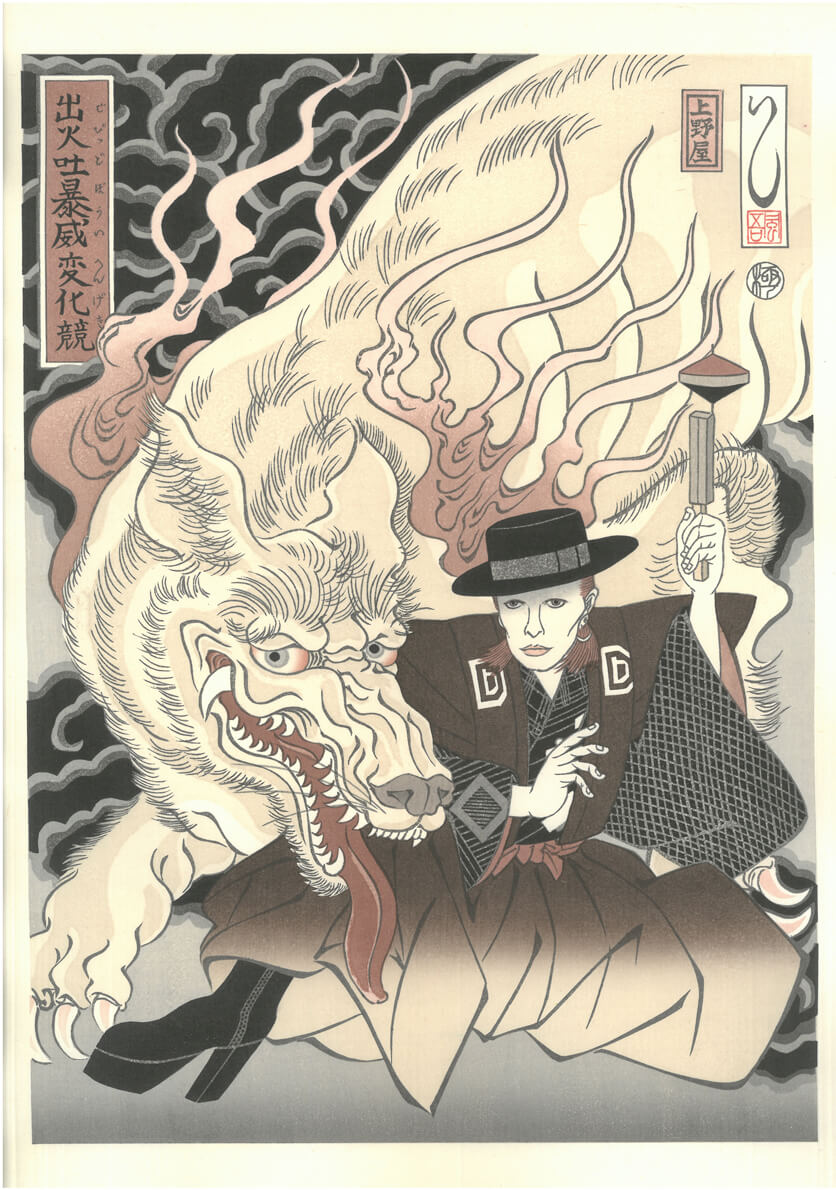New Ukiyo-e Creations Inspired by David Bowie

Image courtesy of Marc Jacobs Japan
From Saturday 23 June to Sunday 1 July, an exhibition will be presented by the UKIYO-E PROJECT at BOOKMARC in Harajuku, Tokyo, spotlighting two new Ukiyo-e prints depicting David Bowie. Both prints will be available for purchase.
Ukiyo-e is a style of multi-coloured woodblock printing independently developed by Japanese craftsmen from the early to middle Edo period (roughly the mid-seventeenth century to the mid-eighteenth century). As the term uki within the expression ‘Ukiyo-e’ stands for ‘now’ or ‘contemporary’, the subjects of the pictures include people, scenery and customs that were popular during the particular era in which the prints were produced.
The UKIYO-E PROJECT, having inherited the genre’s spirit of ‘depicting the present’, was launched with the intention of portraying contemporary stars using Ukiyo-e. Artists successfully featured so far have been the American group KISS—leaders of the rock scene for several decades—and a collaboration with the British heavy-metal band Iron Maiden.
The two prints this time, representing the third instalment of the series, throw the spotlight on the British musician David Bowie, who died suddenly in 2016. They were produced by the Ukiyo-e artist Masumi Ishikawa based on the album cover for ‘Aladdin Sane’ (Brian Duffy, 1973) and the promotional photograph ‘Diamond Dogs’ (Terry O’Neill, 1974).

Image courtesy of Marc Jacobs Japan
Although Ukiyo-e, on account of its classic image, tends to be viewed as a type of traditional artwork that used to be produced a long time ago, the Bowie prints illustrate the truth that ‘Ukiyo-e continues to live now’.
Just as Bowie has inspired new Ukiyo-e creations, Ukiyo-e has vividly brought Bowie back to life. Don’t miss the chance of experiencing the excitement of seeing such prints for yourself at the exhibition this time!

Image courtesy of Marc Jacobs Japan
TRENDING
-
The Tattoos that Marked the Criminals of the Edo Period
Traditional tattoos were strong signifiers; murderers had head tattoos, while theft might result in an arm tattoo.

-
Paris, Tokyo: Robert Compagnon
With his co-chef and talented wife, Jessica Yang, Robert Compagnon opened one of the top new restaurants in Paris: Le Rigmarole.
 3:31
3:31 -
Chiharu Shiota, Red Threads of the Soul
Last year, more than 660,000 people visited the retrospective 'Chiharu Shiota: The Soul Trembles' exhibit at the Mori Art Museum.

-
‘Before Doubting Others, Doubt Yourself. Who Can Truly Say a Dish Isn’t What It Used to Be?’
In ‘A Non-Conformist’s Guide to Surviving Society’, author Satoshi Ogawa shares his strategies for navigating everyday life.

-
The Story of Sada Yacco, the Geisha who Bewitched Europe
Described by Dazed magazine as the first beauty influencer, she has been restored to her former glory since 2019.





